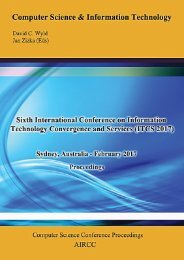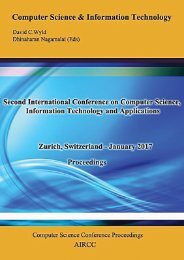CoSIT 2017
Fourth International Conference on Computer Science and Information Technology ( CoSIT 2017 ), Geneva, Switzerland - March 2017
Fourth International Conference on Computer Science and Information Technology ( CoSIT 2017 ), Geneva, Switzerland - March 2017
Create successful ePaper yourself
Turn your PDF publications into a flip-book with our unique Google optimized e-Paper software.
148 Computer Science & Information Technology (CS & IT)<br />
languages was less common [9]. A limited number of tagged items, formatting errors and other<br />
inconsistencies lead to difficulties in accurately identifying and parsing common textual subjects<br />
across multiple filings [10] [11] [7]. These issues directly affect the ability to automate the<br />
extraction of textual information from SEC submissions [10] [12] [13]. Business data providers<br />
are offering expensive commercial products (e.g. AcademicEDGAR+, Edgar Pro, Intelligize). As<br />
research in the context of textual analysis is growing (e.g. Tetlock 2007 [14]; Loughran and<br />
McDonald 2011a [15]; Jegadeesh and Wu 2013 [16]) the question occurs which particular<br />
financial statements and disclosures are publicly available for free, how to retrieve these<br />
corporate documents and how to decode the embedded textual information in order to be<br />
incorporated into investment decisions, trading strategies and research studies in financial<br />
economics [5].Today only a very limited amount of specific literature for extracting textual<br />
information from financial statements filed with the SEC and its EDGAR system is available<br />
(except Gerdes 2003 [10]; Stümpert et al. 2004 [17]; Grant and Conlon 2006 [1]; Engelberg and<br />
Sankaraguruswamy 2007 [18]; Cong, Kogan and Vasarhelyi 2007 [19]; Thai et al. 2008 [20];<br />
Chakraborty and Vasarhelyi 2010 [21]; Hernandez et al. 2010 [22]; Garcia and Norli 2012 [5];<br />
Srivastava 2016 [23]). This paper is based on neither of these because first, non-specialist<br />
technology is used to retrieve financial statements in an efficient way and secondly, the algorithm<br />
designed to extract textual information is platform-independent. The suggested method can<br />
compensate for expensive commercial products and help to replicate empirical research results.<br />
The paper shall serve as a technical guide on how to retrieve financial statements filed with the<br />
SEC and how to decode the embedded textual information provided by the EDGAR system for<br />
business and research purposes.<br />
The remainder of the paper proceeds as follows. Section 2 presents the amount and variety of<br />
corporate documents distributed by the SEC´s electronic disclosure system. Section 3<br />
demonstrates how to retrieve these documents from the EDGAR database. Section 4 describes the<br />
fundamentals of HyperText Markup Language and examines the electronic data provided by the<br />
SEC. Section 5 describes the fundamentals of regular expressions and specifies an algorithm to<br />
extract textual information embedded in financial statements. Section 6 validates the capabilities<br />
of the extraction algorithm. Section 7 presents descriptive statistics of annual reports filed with<br />
the EDGAR database. The last section concludes.<br />
2. SEC´S EDGAR DATABASE<br />
Publicly owned companies, their officers and directors as well as major investors are obligated by<br />
law (Securities Exchange Act 1934, Section 2) to file various disclosures (forms) with the SEC<br />
[10]. The main purpose of making certain types of corporate information publicly available is to<br />
improve the efficiency of security markets and to protect capital market participants [5]. “The<br />
laws and rules that govern the securities industry in the United States derive from a simple and<br />
straightforward concept: all investors, whether large institutions or private individuals, should<br />
have access to certain basic facts about an investment prior to buying it, and so long as they hold<br />
it. To achieve this, the SEC requires public companies to disclose meaningful financial and other<br />
information to the public. This provides a common pool of knowledge for all investors to use to<br />
judge for themselves whether to buy, sell, or hold a particular security” [24]. In order to protect<br />
investors, to maintain efficient capital markets and to improve access to publicly available<br />
corporate disclosures, the SEC developed the EDGAR database [10] and describes it as a system<br />
which “performs automated collection, validation, indexing, acceptance, and forwarding of





